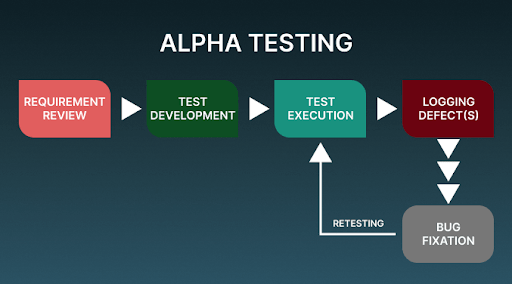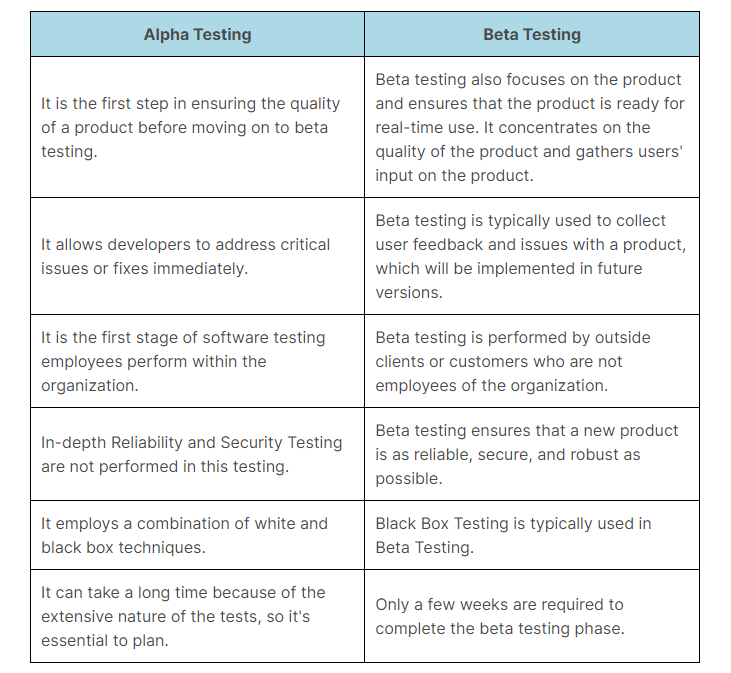Alpha testing is a procedure that helps developers find and address faults in their software products. It is comparable to user acceptance testing, another kind of quality control. The main goal of Alpha test is to fine-tune a software product by uncovering and fixing faults that were not addressed during the initial phases of development.
While developing new software applications, many organizations overlook conducting Alpha tests. It focuses on particular product areas to detect and correct flaws missed during software development.
What is Alpha Testing?
Alpha testing is the way to determine whether a product meets its performance standards before it is released. It is carried out by the product developers and engineers, who are familiar with the product’s expected functions. This is followed by beta testing, in which a sampling of the intended audience tries the product out.
Alpha tests is considered a type of user acceptance testing. It’s designed to refine software products by finding and fixing bugs that have escaped notice during previous tests.
Alpha is the first software testing phase, which takes place very early in the development cycle. Software engineers perform it to identify any flaws in the design of a program before it enters beta testing, where other users interact with it for the first time. The term “Alpha” comes from a tradition in which code is labeled alphabetically. It is usually performed using white box testing and black box testing techniques.
Explore the power of Cypress Cloud for seamless testing automation.
Objectives of Alpha Testing
It is important to know what you are looking for and why you are looking for it when performing Alpha testing. If the data obtained from this testing is not actionable, it would be better to find out as soon as possible in the development cycle so that further time and money do not need to be spent on unnecessary tests. The following lists some objectives of Alpha test.
It is a crucial stage in the development process, where software engineers identify and fix problems with the product before it is released to the public.
To involve customers in the development process so that they can help shape the product.
To verify the reliability of software products at the early stages of development.
Advantages of Alpha Testing
The advantages of Alpha tests in software engineering include:
Provides crucial insights into the dependability of the software while also shedding light on the potential issues that could arise.
Helps the software team gain confidence in their product before releasing the application in the market.
It frees up your team to focus on other projects.
Early feedback from Alpha testers helps companies to improve the quality of their products.
It allows developers to get user feedback, which benefits the design process. This process also helps stakeholders determine which features of a new piece of software to optimize.
Enhance your testing strategy with Playwright Test and achieve better results.
Disadvantages of Alpha Testing
The disadvantages of Alpha testing in software engineering include:
If the defects stay uncovered, they will remain in the software application. The primary purpose of Alpha tests is to test users’ reactions to the application, not to find defects.
It replicates the production environment, but some defects arise because of environmental issues. These issues don’t exist in the production environment, so they’re not present in Alpha tests.
When it comes to small-size projects, Alpha tests is not necessary. Time and money are proportional in an IT project. Furthermore, increasing the budget increases the project implementation period.
For large projects that have already undergone rigorous testing, performing Alpha tests on them can be time-consuming. Due to a very high probability of bugs, a proper test plan and documentation work need to be done, which indirectly is a reason for the release delay.
Phases of Alpha Testing
Alpha testing consists of two phases:
Phase 1: Software engineers use debugging tools in the first phase to improve the process and find all bugs as quickly as possible. The main aim is to ensure the software works according to plan.
Phase 2: The quality assurance team conducts the second testing phase, including black box and white box testing. The primary purpose is to discover bugs that escaped previous tests.
By doing so, the quality assurance team can fix any bugs in the system just before releasing it for beta testing; this ensures the program’s quality will be high when it reaches the end user.
Alpha Testing Process
Alpha testing has the following process:
Requirement Review: In the first stage of this process, the developers and engineers must evaluate the specification and functional requirements design and recommend changes.
Test Development: Test development is based on the result of the required review. The test plan and test cases are created based on the review’s outcome, which shows how testing will occur.
Test Case Design: In this stage, the execution of the developed test plan and test case takes place.
Logging Defects: As part of the debugging process, the identified bugs are logged. Logging the identified and detected bugs can help developers spot recurring bugs and suggest fixes.
Fixing the Bugs: Once defects and bugs are identified by the testers, they are logged, and steps are taken to fix them.
Retesting: After the identified bugs are fixed, testers retest the product to find out any unidentified or new bugs or errors.

Learn the best practices for testing web applications with our comprehensive guide.
Alpha Testing vs. Beta Testing
Here is a detailed comparison between Alpha and Beta testing.

Discover the best android emulator for ios to streamline your development process.
How to Perform Alpha Testing?
Testing should be considered an ongoing process that begins when the requirements for a system are first defined and continues until the system is no longer in use, even if it does not get formal testing activities every day or week. Testing can include both functional and non-functional tests, but not all types of tests can be performed at this stage.
Alpha tests should only be done after a product has passed unit and integration testing. A group of users, including end users and developers, should test the product before beta testing starts. This group of users should not be limited to one or two testers. The more testers involved in alpha test, the better chances that bugs will be found early enough to correct before they become serious problems.
Instead of trying to test your website on every device and operating system your audience uses, consider using a cloud-based testing infrastructure like LambdaTest.
LambdaTest’s real device cloud offers 3000+ real browsers, devices, and OS for manual and automation testing. This extensive range allows you to check how your website or app renders and works on different browsers, devices, and OSes. Using LambdaTest’s automation cloud, you can achieve faster test execution speed and developer feedback thereby reducing overall costs related to fixing problems later in the software development cycle.
With the LambdaTest automation testing platform, you can automate web testing with various automated testing tools like Selenium, Cypress, Playwright, Puppeteer, TestCafe, Appium, Espresso, etc.
Subscribe to the LambdaTest YouTube channel and stay updated with the latest tutorials around Selenium testing, Cypress testing, CI/CD, and more.
Use our online emulator android to test your apps across different devices.
Alpha Testing Best Practices
After discussing the process of performing Alpha tests, here are a few best practices to make the most out of it:
Recording Every Issue: It’s a good idea to record everything during your Alpha test because you may want to return to these issues later, or they might be ready for post-release evaluation.
Don’t Rely Completely on Beta Testing: Testers might find the same issues during Beta testing as during Alpha testing. But there is no certainty of finding the same problems. However, the more issues and bugs are identified and resolved during Alpha tests, the more superior the product will be perceived by public beta testers.
Examine the Specifications: Before starting Alpha tests, It is crucial to review the operational and testing requirements. Doing this provides meaning and purpose for all the effort while providing general common knowledge.
Monitor Full Customer’s Experience: The developed test cases should cover an actual user’s complete experience of engaging with the product. A product may perform, but it may not be useful for a more extensive dealing with all the issues.
Involve Non-technical Team Members: When it comes to testing, technical people can be more lenient with bugs and application issues c ompared to non-technical and daily users. Thus, involving non-technical people in Alpha tests can give a deeper look into the usability and performance issues.
Try our android online emulator for efficient and accurate testing.
Wrap Up!
Alpha testing is a vital phase in the software development lifecycle. It involves testing the functionality of a software product in a real environment and achieving confidence in its users’ acceptance of the product before releasing it into the market.
